An electric guitar played through an amplifier is a fantastic combination. Capable of volume, tone and of course, distortion, the amplifier is undoubtedly as much a part of the player’s sound as their instrument is.
Contributed by Byron Struck for Roland Corporation Australia
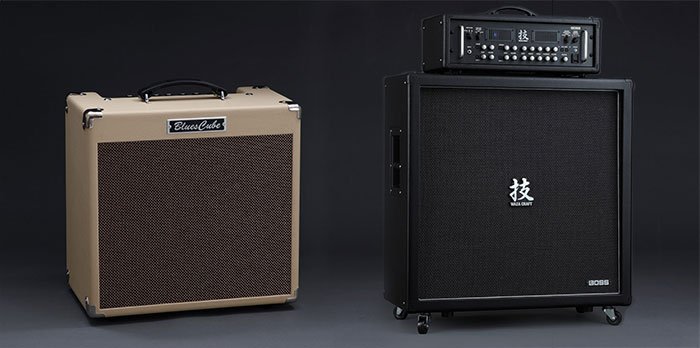 The one thing that these main amplifier tones (and variations of) all have in common, is that they’re famous for their distorted sounds.
Heard throughout most guitar based music from the late 1940s onwards, a distorted amplifier sound has become one of the most instantly recognisable, beloved and powerful forces in music history.
The one thing that these main amplifier tones (and variations of) all have in common, is that they’re famous for their distorted sounds.
Heard throughout most guitar based music from the late 1940s onwards, a distorted amplifier sound has become one of the most instantly recognisable, beloved and powerful forces in music history.
 First introduced way back in 1975, the JC-120 Jazz Chorus is one of the few guitar amps that can truly be called a legend.
Roland’s long-standing flagship amplifier enjoys universal recognition by pros as the benchmark in clean guitar sound. Its rich tone and famous built-in stereo chorus effect appear on countless popular songs over its long history.
Now, celebrating 40 years of continuous production and counting, the JC-120 remains the undisputed “king of clean”, and the enduring choice for serious guitarists everywhere.
First introduced way back in 1975, the JC-120 Jazz Chorus is one of the few guitar amps that can truly be called a legend.
Roland’s long-standing flagship amplifier enjoys universal recognition by pros as the benchmark in clean guitar sound. Its rich tone and famous built-in stereo chorus effect appear on countless popular songs over its long history.
Now, celebrating 40 years of continuous production and counting, the JC-120 remains the undisputed “king of clean”, and the enduring choice for serious guitarists everywhere.
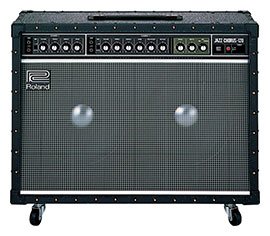 Part of it has to do with a main point of difference that set the JC-120 apart from other amplifiers at its time of release. This is, that it used solid-state circuitry. Traditionally, guitar amplifiers had been overwhelmingly tube based.
The JC-120’s designers took a different approach when building the amplifier. They used the solid-state circuit to create a stable tone that wasn’t susceptible to changes in temperature. Solid-state circuits also reduce the maintenance that tube amplifiers need.
The JC-120’s dual power amplifier and custom-designed speakers also gave the amp a slight edge over other amps of the time. The speakers covered a wider audio spectrum and had less high peaks, resulting in a smooth, mid-ranged voice that perfectly suited guitar tones.
To increase clarity, designers added a BRIGHT switch. This wasn’t simply an additional EQ control, but a way to enhance the high frequency.
Interacting with the VOLUME control, the Bright switch lowers the high frequency’s balance when the Volume increases. As such, it allows the player more shaping and tonal possibilities, as well as smoothing out harsher frequencies that can emerge in the upper registers.
Part of it has to do with a main point of difference that set the JC-120 apart from other amplifiers at its time of release. This is, that it used solid-state circuitry. Traditionally, guitar amplifiers had been overwhelmingly tube based.
The JC-120’s designers took a different approach when building the amplifier. They used the solid-state circuit to create a stable tone that wasn’t susceptible to changes in temperature. Solid-state circuits also reduce the maintenance that tube amplifiers need.
The JC-120’s dual power amplifier and custom-designed speakers also gave the amp a slight edge over other amps of the time. The speakers covered a wider audio spectrum and had less high peaks, resulting in a smooth, mid-ranged voice that perfectly suited guitar tones.
To increase clarity, designers added a BRIGHT switch. This wasn’t simply an additional EQ control, but a way to enhance the high frequency.
Interacting with the VOLUME control, the Bright switch lowers the high frequency’s balance when the Volume increases. As such, it allows the player more shaping and tonal possibilities, as well as smoothing out harsher frequencies that can emerge in the upper registers.
 There’s also the famous chorus effect that’s in the name of the amplifier. Chorus is an effect that duplicates an input signal and then slows down that second (duplicate) signal. It then recombines it with the unaffected (dry) signal at the output stage.
This can result in a lush, spacious, delayed kind of sound, or a whirring, fluctuating kind of effect. In fact, chorus can simulate the famous rotating speaker sound, usually used by organ players.
There’s also the famous chorus effect that’s in the name of the amplifier. Chorus is an effect that duplicates an input signal and then slows down that second (duplicate) signal. It then recombines it with the unaffected (dry) signal at the output stage.
This can result in a lush, spacious, delayed kind of sound, or a whirring, fluctuating kind of effect. In fact, chorus can simulate the famous rotating speaker sound, usually used by organ players.
 The amp’s chorus sound was so popular that BOSS released it as a separate effect pedal, in the form of the (now legendary) BOSS CE-1 Chorus Ensemble.
This milestone pedal is important for a few reasons.
First of all, it was the very first BOSS pedal and launched the most famous name in effects pedals, ever.
Secondly, it was also the world’s first chorus pedal, starting a whole line of legendary BOSS chorus effects from the classic CE-2, right up to today with the CE-5 Chorus Ensemble, the CE-2W Chorus and CH-1 Super Chorus.
The amp’s chorus sound was so popular that BOSS released it as a separate effect pedal, in the form of the (now legendary) BOSS CE-1 Chorus Ensemble.
This milestone pedal is important for a few reasons.
First of all, it was the very first BOSS pedal and launched the most famous name in effects pedals, ever.
Secondly, it was also the world’s first chorus pedal, starting a whole line of legendary BOSS chorus effects from the classic CE-2, right up to today with the CE-5 Chorus Ensemble, the CE-2W Chorus and CH-1 Super Chorus.
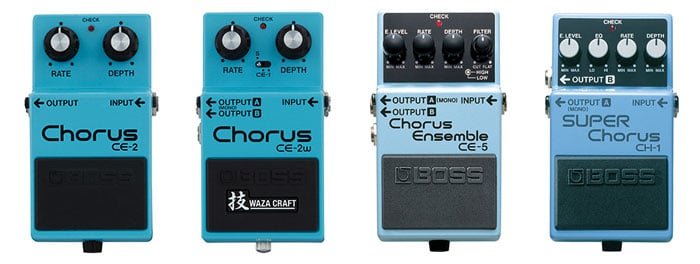 All of these pedals have their own individual tones, but they can all be traced right back to the original design found in the JC-120 amplifier.
All of these pedals have their own individual tones, but they can all be traced right back to the original design found in the JC-120 amplifier.
 “I came out at a time when there were a lot of “no-no’s” in guitar culture. It’s gone down as being post-punk, but it was actually the birth of what has come to be known as indie rock now.
And with that there were some musical politics, throwing away everything that had happened in the previous generations of rock culture, which was a lot of distortion, bluesy playing, extended solos, fast solos, and effects. All of those things were considered passé and somewhat outdated in the culture that I came out of.
And the Roland JC-120 was a brand-new innovation [at the time]. To use a Roland amp was very unusual and exciting and a lot of people did it. I got one as soon as I could afford one.
That was a big part of my sound, you know, that clean, chorus-y sound. It’s not really a surprise that your gear dictates the way you play, and so I was fortunate.
The interesting thing is that now—many, many, many years later—kids still ask me about playing the JC-120. They like that sound. I’ve had quite a few people really geeking out over the JC-120.”
“I came out at a time when there were a lot of “no-no’s” in guitar culture. It’s gone down as being post-punk, but it was actually the birth of what has come to be known as indie rock now.
And with that there were some musical politics, throwing away everything that had happened in the previous generations of rock culture, which was a lot of distortion, bluesy playing, extended solos, fast solos, and effects. All of those things were considered passé and somewhat outdated in the culture that I came out of.
And the Roland JC-120 was a brand-new innovation [at the time]. To use a Roland amp was very unusual and exciting and a lot of people did it. I got one as soon as I could afford one.
That was a big part of my sound, you know, that clean, chorus-y sound. It’s not really a surprise that your gear dictates the way you play, and so I was fortunate.
The interesting thing is that now—many, many, many years later—kids still ask me about playing the JC-120. They like that sound. I’ve had quite a few people really geeking out over the JC-120.”
 Among the many users of the Roland JC-120 is Andy Summers of The Police, whose shimmering, sparkling guitar tone helped define the chart-topping band’s sound.
Says Andy of the JC-120, “I have used it on many recordings for its distinctive clarity of sound and always-superior chorus. It is a no-fail amp in just about every situation.”
Among the many users of the Roland JC-120 is Andy Summers of The Police, whose shimmering, sparkling guitar tone helped define the chart-topping band’s sound.
Says Andy of the JC-120, “I have used it on many recordings for its distinctive clarity of sound and always-superior chorus. It is a no-fail amp in just about every situation.”
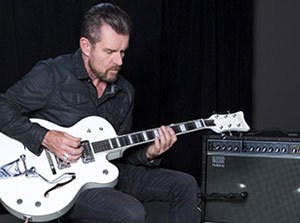 Billy Duffy of UK Rock legends The Cult is another JC-120 disciple. The amplifier appears prominently on many of the band’s classic albums, like Love, and it’s a staple part of Billy’s live rig.
The guitarist explains – “I use the JC-120 for my clean sound, and I’ve always used it in combination with a valve amp, l think 99 percent of the time. The chorus itself is really sweet. It’s just a go-to amp for the clean sound and the chorus effect.”
Billy Duffy of UK Rock legends The Cult is another JC-120 disciple. The amplifier appears prominently on many of the band’s classic albums, like Love, and it’s a staple part of Billy’s live rig.
The guitarist explains – “I use the JC-120 for my clean sound, and I’ve always used it in combination with a valve amp, l think 99 percent of the time. The chorus itself is really sweet. It’s just a go-to amp for the clean sound and the chorus effect.”
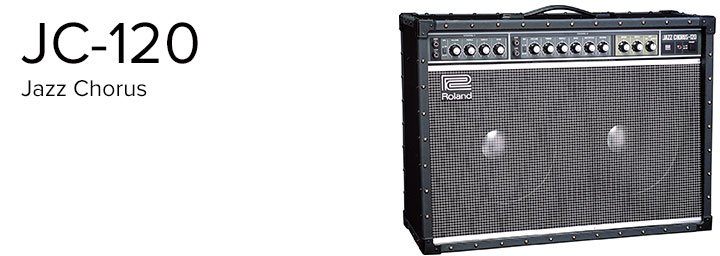
Do You Have Your Tone?
If you’re a guitar player, chances are you’ll have one of a few key amp tones that you like to use. Maybe it’s a classic British vintage combo with a bit of hair, like Keith Richards’ tone. Perhaps you’re more of a smooth, creamy American “tweed” player, with bite, growl and a singing sustain in your tone. Are you into something louder, like a big stack-style setup, which screams, grunts and roars from heavy overdrive? You might even be into all of these! The one thing that these main amplifier tones (and variations of) all have in common, is that they’re famous for their distorted sounds.
Heard throughout most guitar based music from the late 1940s onwards, a distorted amplifier sound has become one of the most instantly recognisable, beloved and powerful forces in music history.
The one thing that these main amplifier tones (and variations of) all have in common, is that they’re famous for their distorted sounds.
Heard throughout most guitar based music from the late 1940s onwards, a distorted amplifier sound has become one of the most instantly recognisable, beloved and powerful forces in music history.
Is Overdrive All That There Is? No!
You could easily divide the most famous distorted guitar tones among a handful of different amplifiers. These distorted tones have helped to shape Rock and other music for decades. But what about other guitar tones? The ones that aren’t distorted, biting, snarling, roaring or hairy? The ones that don’t use huge volume levels or overdrive to create their signature sounds? The tones that are clean? There are very few amplifiers that are synonymous with clean sounds. Far less than those associated with overdriven tones. From that small and select group, there is one amplifier that has become both an industry standard and a beloved go-to for artists wanting clean sounds. That amplifier is the Roland Jazz Chorus. First introduced way back in 1975, the JC-120 Jazz Chorus is one of the few guitar amps that can truly be called a legend.
Roland’s long-standing flagship amplifier enjoys universal recognition by pros as the benchmark in clean guitar sound. Its rich tone and famous built-in stereo chorus effect appear on countless popular songs over its long history.
Now, celebrating 40 years of continuous production and counting, the JC-120 remains the undisputed “king of clean”, and the enduring choice for serious guitarists everywhere.
First introduced way back in 1975, the JC-120 Jazz Chorus is one of the few guitar amps that can truly be called a legend.
Roland’s long-standing flagship amplifier enjoys universal recognition by pros as the benchmark in clean guitar sound. Its rich tone and famous built-in stereo chorus effect appear on countless popular songs over its long history.
Now, celebrating 40 years of continuous production and counting, the JC-120 remains the undisputed “king of clean”, and the enduring choice for serious guitarists everywhere.
What Makes The JC-120 So Inspiring And Special?
 Part of it has to do with a main point of difference that set the JC-120 apart from other amplifiers at its time of release. This is, that it used solid-state circuitry. Traditionally, guitar amplifiers had been overwhelmingly tube based.
The JC-120’s designers took a different approach when building the amplifier. They used the solid-state circuit to create a stable tone that wasn’t susceptible to changes in temperature. Solid-state circuits also reduce the maintenance that tube amplifiers need.
The JC-120’s dual power amplifier and custom-designed speakers also gave the amp a slight edge over other amps of the time. The speakers covered a wider audio spectrum and had less high peaks, resulting in a smooth, mid-ranged voice that perfectly suited guitar tones.
To increase clarity, designers added a BRIGHT switch. This wasn’t simply an additional EQ control, but a way to enhance the high frequency.
Interacting with the VOLUME control, the Bright switch lowers the high frequency’s balance when the Volume increases. As such, it allows the player more shaping and tonal possibilities, as well as smoothing out harsher frequencies that can emerge in the upper registers.
Part of it has to do with a main point of difference that set the JC-120 apart from other amplifiers at its time of release. This is, that it used solid-state circuitry. Traditionally, guitar amplifiers had been overwhelmingly tube based.
The JC-120’s designers took a different approach when building the amplifier. They used the solid-state circuit to create a stable tone that wasn’t susceptible to changes in temperature. Solid-state circuits also reduce the maintenance that tube amplifiers need.
The JC-120’s dual power amplifier and custom-designed speakers also gave the amp a slight edge over other amps of the time. The speakers covered a wider audio spectrum and had less high peaks, resulting in a smooth, mid-ranged voice that perfectly suited guitar tones.
To increase clarity, designers added a BRIGHT switch. This wasn’t simply an additional EQ control, but a way to enhance the high frequency.
Interacting with the VOLUME control, the Bright switch lowers the high frequency’s balance when the Volume increases. As such, it allows the player more shaping and tonal possibilities, as well as smoothing out harsher frequencies that can emerge in the upper registers.
Clean And Effective Detail For Your Tone
While the amplifier is famous for its clean sound, distorting it is possible. The distortion on the JC-120 isn’t excessive, but it’s there to provide extra detail in harmonics and to thicken the guitar tone. It’s also useful for boosting any effects pedals that the player uses with the amp. Speaking of pedals and the JC-120, they’re practically made for each other! Among the amplifier’s many accomplishments, it’s also earned a reputation as the “pedal platform amp”. Engineers at Roland always knew that the JC-120 needed to handle versatile guitar sounds. Due to the variable nature of pedal stompboxes, especially distortions, the JC-120’s broad tonal range and clear signal representation makes it an ideal blank canvas to use pedals with. Plus, the stereo abilities of the amp are perfect for dual output pedals, like reverb and delay and they help reduce the need to lug two amps to a show! There’s also the famous chorus effect that’s in the name of the amplifier. Chorus is an effect that duplicates an input signal and then slows down that second (duplicate) signal. It then recombines it with the unaffected (dry) signal at the output stage.
This can result in a lush, spacious, delayed kind of sound, or a whirring, fluctuating kind of effect. In fact, chorus can simulate the famous rotating speaker sound, usually used by organ players.
There’s also the famous chorus effect that’s in the name of the amplifier. Chorus is an effect that duplicates an input signal and then slows down that second (duplicate) signal. It then recombines it with the unaffected (dry) signal at the output stage.
This can result in a lush, spacious, delayed kind of sound, or a whirring, fluctuating kind of effect. In fact, chorus can simulate the famous rotating speaker sound, usually used by organ players.
The Chorus With One Million Voices – And Counting!
At the time of the JC-120’s 1975 release, chorus as a standalone effect didn’t exist. Roland’s built-in “Dimensional Space Chorus” had a two-fold result. It not only set the JC-120 apart from other amplifiers, but also from other effects units of the time. The amp’s chorus sound was so popular that BOSS released it as a separate effect pedal, in the form of the (now legendary) BOSS CE-1 Chorus Ensemble.
This milestone pedal is important for a few reasons.
First of all, it was the very first BOSS pedal and launched the most famous name in effects pedals, ever.
Secondly, it was also the world’s first chorus pedal, starting a whole line of legendary BOSS chorus effects from the classic CE-2, right up to today with the CE-5 Chorus Ensemble, the CE-2W Chorus and CH-1 Super Chorus.
The amp’s chorus sound was so popular that BOSS released it as a separate effect pedal, in the form of the (now legendary) BOSS CE-1 Chorus Ensemble.
This milestone pedal is important for a few reasons.
First of all, it was the very first BOSS pedal and launched the most famous name in effects pedals, ever.
Secondly, it was also the world’s first chorus pedal, starting a whole line of legendary BOSS chorus effects from the classic CE-2, right up to today with the CE-5 Chorus Ensemble, the CE-2W Chorus and CH-1 Super Chorus.
 All of these pedals have their own individual tones, but they can all be traced right back to the original design found in the JC-120 amplifier.
All of these pedals have their own individual tones, but they can all be traced right back to the original design found in the JC-120 amplifier.
Technology, Revolution And The Music That It Inspires
As we’ve seen over the years, developments in technology can help to shape musical innovations. Roland have a knack for creating products that are often ahead of the curve of what’s happening in music. Many times, we’ve seen products released (like the TR-808 drum machine or the HM-2 distortion pedal) which go on to have a second life, shaping new music styles and achieving a legendary status over time. It’s interesting to note that the JC-120 has had a similar journey. The JC-120 appeared in the mid-1970s, at a time when Jazz Fusion was very popular. Bands like Weather Report, Return to Forever and The Mahavishnu Orchestra were combining Jazz with Rock and synthesizers to create wildly original and adventurous new music. So, the “Jazz” in Jazz Chorus was intentional in the timing of the JC-120’s release. Although being very successful ever since its release in 1975, the JC-120 also went on to find acclaim with many artists that emerged after the 70s. As we know, much of the guitar music of the 1970s was about loud, overdriven amplifiers. Fast forward a few years to the 1980s, Punk had been and gone, 70s rock was over and a new sound was brewing, particularly in Britain. Bands like Joy Division, New Order, The Cure, The Smiths and Australia’s The Birthday Party were reshaping the classic guitar/bass/drums/vocal band form into something more introverted and stripped back than the guitar music of the previous decade. This new music also required a different guitar tone than the familiar overdriven amp stack sound of the 70s. This quote from The Smiths’ Johnny Marr captures the essence of this time perfectly. “I came out at a time when there were a lot of “no-no’s” in guitar culture. It’s gone down as being post-punk, but it was actually the birth of what has come to be known as indie rock now.
And with that there were some musical politics, throwing away everything that had happened in the previous generations of rock culture, which was a lot of distortion, bluesy playing, extended solos, fast solos, and effects. All of those things were considered passé and somewhat outdated in the culture that I came out of.
And the Roland JC-120 was a brand-new innovation [at the time]. To use a Roland amp was very unusual and exciting and a lot of people did it. I got one as soon as I could afford one.
That was a big part of my sound, you know, that clean, chorus-y sound. It’s not really a surprise that your gear dictates the way you play, and so I was fortunate.
The interesting thing is that now—many, many, many years later—kids still ask me about playing the JC-120. They like that sound. I’ve had quite a few people really geeking out over the JC-120.”
“I came out at a time when there were a lot of “no-no’s” in guitar culture. It’s gone down as being post-punk, but it was actually the birth of what has come to be known as indie rock now.
And with that there were some musical politics, throwing away everything that had happened in the previous generations of rock culture, which was a lot of distortion, bluesy playing, extended solos, fast solos, and effects. All of those things were considered passé and somewhat outdated in the culture that I came out of.
And the Roland JC-120 was a brand-new innovation [at the time]. To use a Roland amp was very unusual and exciting and a lot of people did it. I got one as soon as I could afford one.
That was a big part of my sound, you know, that clean, chorus-y sound. It’s not really a surprise that your gear dictates the way you play, and so I was fortunate.
The interesting thing is that now—many, many, many years later—kids still ask me about playing the JC-120. They like that sound. I’ve had quite a few people really geeking out over the JC-120.”
Hear It From The Players That Know
The JC-120’s powerfully clean sound seemed ideal for the time and imaginations of the “New Wave” of pop performers in the early 1980s. Its popularity exploded and the Jazz Chorus started showing up on stages around the world, where it has remained for decades. Notably, it had prominent use at the massive Live Aid charity event in 1985, where artists such as Sting, Adam and the Ants, Paul Weller (The Jam/Style Council) and The Boomtown Rats all played through it. Not confined to one musical era, it’s appeared in the rigs of The Edge (U2), Matt Bellamy (Muse), Joe Walsh (The Eagles), Joe Perry (Aerosmith), Wes Borland (Limp Bizkit) and Robert Smith (The Cure). Famously, the JC-120 is also responsible for the clean sounds heard on classic Metallica albums like …And Justice For All and Metallica. Among the many users of the Roland JC-120 is Andy Summers of The Police, whose shimmering, sparkling guitar tone helped define the chart-topping band’s sound.
Says Andy of the JC-120, “I have used it on many recordings for its distinctive clarity of sound and always-superior chorus. It is a no-fail amp in just about every situation.”
Among the many users of the Roland JC-120 is Andy Summers of The Police, whose shimmering, sparkling guitar tone helped define the chart-topping band’s sound.
Says Andy of the JC-120, “I have used it on many recordings for its distinctive clarity of sound and always-superior chorus. It is a no-fail amp in just about every situation.”
 Billy Duffy of UK Rock legends The Cult is another JC-120 disciple. The amplifier appears prominently on many of the band’s classic albums, like Love, and it’s a staple part of Billy’s live rig.
The guitarist explains – “I use the JC-120 for my clean sound, and I’ve always used it in combination with a valve amp, l think 99 percent of the time. The chorus itself is really sweet. It’s just a go-to amp for the clean sound and the chorus effect.”
Billy Duffy of UK Rock legends The Cult is another JC-120 disciple. The amplifier appears prominently on many of the band’s classic albums, like Love, and it’s a staple part of Billy’s live rig.
The guitarist explains – “I use the JC-120 for my clean sound, and I’ve always used it in combination with a valve amp, l think 99 percent of the time. The chorus itself is really sweet. It’s just a go-to amp for the clean sound and the chorus effect.”
Make History With The Sound Of Today
Today, we’re seeing similarities to those heady years when the Roland Jazz Chorus first graced the scene. Modern guitarists are more innovative than ever, using everything from vintage gear to modern tech like DAWs, VSTs and plug-ins. Small pedalboards with a few key effects are gaining popularity and the JC-120 offers a perfect canvas on which to craft unique tones and textures. The JC-120 is so iconic, that it’s still in production today. To our knowledge it’s the only guitar amplifier ever to remain in constant production for 40 years! Still a best-seller, the JC-120 Jazz Chorus now sits alongside it’s stablemates like the JC-40, which is perfect for smaller club stages and the JC-22, which brings the famous JC clean tone into the bedroom, office or home studio. Of course, nothing is quite like the original itself, which is clear from the ongoing demand for this legendary amplifier ever since its release! You can read more about the evolution and development of the Roland Jazz Chorus at this micro-site, celebrating 40 years of Jazz Chorus!Related Articles
BOSS CULT CLASSICS INSIDE A GUITAR AMPLIFIER – PART. 1 INSIDE A GUITAR AMPLIFIER – PART. 2Related Product




